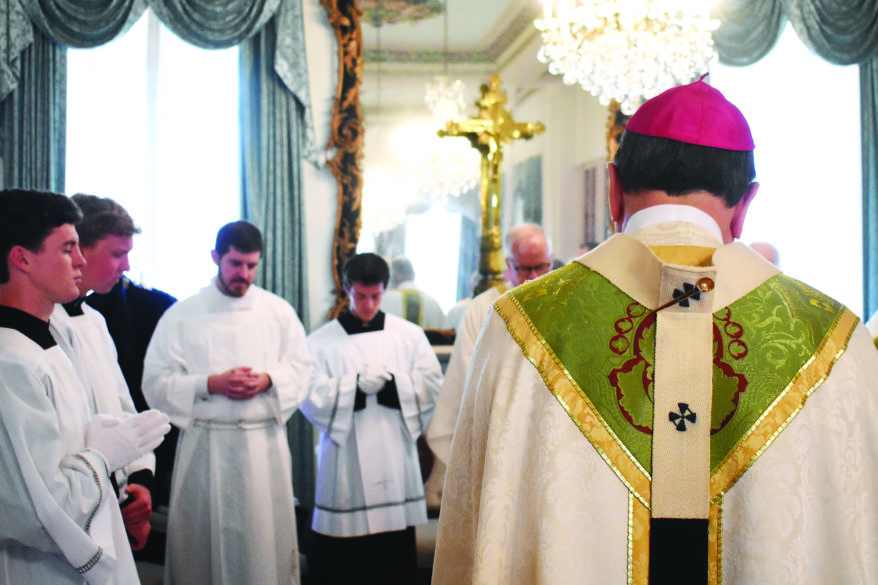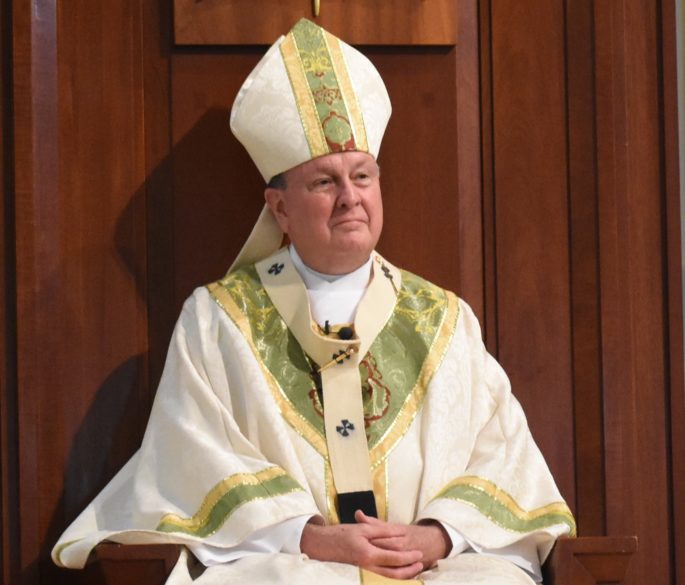FROM THE ARCHIVES
By Mary Woodward
JACKSON – Traditionally, June is the month on the Roman Catholic calendar when on the Solemnity of Sts. Peter and Paul (June 29), each newly named metropolitan archbishops is given a pallium by the Holy Father. Pallium is a Latin word that means a mantle or cloak.
Made of lamb’s wool, the pallium is a white band measuring about two- and one-half inches in width. Two equally wide bands, about 15 inches long containing small silk-covered lead pieces, extend one in front and one down the back. It is worn over the chasuble.
The pallium is decorated with six black crosses placed in the front and back, on each shoulder, and on the ends of the pieces hanging in front and back. Three pins, spinula in Latin for thorn, are placed in the crosses on the front, the back and the left shoulder.
The following historical description is taken from the Vatican’s website:
“The Liber Pontificalis (Pontifical Book) notes that Pope St. Mark (died 336) conferred the pallium on the Suburbicarian Bishop of Ostia, one of the consecrators of the Roman Pontiff. Even if we cannot be sure of the historic value of this information, at least it reflects the practice of the fifth and sixth centuries, when the Liber Pontificalis was compiled by the Roman Curia.”
“In 513, Pope Symmachus granted the privilege of the pallium to St. Caesarius of Arles and thereafter the concession of the pallium by the Pope to the bishops of Italy and outside Italy multiplied.”
“The pallium is the symbol of a special relationship with the Pope and expresses the power, that, in communion with the Church of Rome, the metropolitan acquires by right in his own jurisdiction.
According to Canon Law (canon 437), a metropolitan must request the pallium within three months of his appointment and may wear it only in the territory of his own diocese and in the other dioceses of his ecclesiastical province.”
Spiritually speaking, the pallium’s unique design represents a yoke placed on an ox. The one who takes up the yoke carries the church on his shoulders, plowing through the many challenges and yet the many joys of church life.

Traditionally, on the feast of St. Agnes (Jan. 21), two lambs are brought from Tre Fontane, the site of St. Paul’s martyrdom, to the Basilica of St. Agnes on the Via Nomentana. After they are blessed, the sheep are presented to the Pope, then they remain in the care of the women religious who reside at the Basilica of St. Cecilia in Trastevere.
Just before Easter, these lambs are shorn and their wool is used to make the pallia for newly appointed archbishops. On the night of June 28, the pallia are placed beneath the main altar of the Basilica of St. Peter in Rome where they lie close to the tomb of the first pope.
In receiving his papal pallium when installed in 2005, Pope Benedict XVI in his homily stated: “The symbolism of the pallium is even more concrete: the lamb’s wool is meant to represent the lost, sick or weak sheep which the shepherd places on his shoulders and carries to the waters of life.”
In June 2008, I was privileged to travel to Rome with Bishop Joseph Latino and Bishop Emeritus William Houck for the conferral of the pallia on all the new archbishops of the world by Pope Benedict XVI. This included our current metropolitan, Archbishop Thomas Rodi of Mobile.
One of my main tasks was to pack and unpack cassocks according to the ceremony of the day and keep them wrinkle free. I like to joke that it was a terribly demanding job, but it was not. It truly was a blessing, especially considering I was in Rome participating in such a beautiful church tradition.
Throughout the weeklong trip, it was about 99 degrees outside and inside was only slightly less hot. There is air-conditioning in Rome hotels, but basically it is a box on the wall that makes a lot of noise and drips water on the floor.
The two bishops and I celebrated Mass in four major basilicas in Rome – Peter, Paul, John Lateran and my favorite, St. Mary Major. We managed the heat fairly well and became quite adept at hailing taxis.
The day of the Pallium Mass in St. Peter Basilica, I positioned myself along the rail so that I would be close to the procession. I do not recall how many new metropolitans were there besides ours, but I do remember as they processed out through the basilica, they all looked so serene and otherworldly in their red chasubles and newly placed pallia.
It was the look of being swept up into the heart of the triune God; to being entrenched in the 2000-year tradition of our church; and to being surrounded and bolstered by the Communion of Saints ready to bear the yoke and till the soil in God’s vineyard.
(Mary Woodward is Chancellor and Archivist for the Diocese of Jackson)

